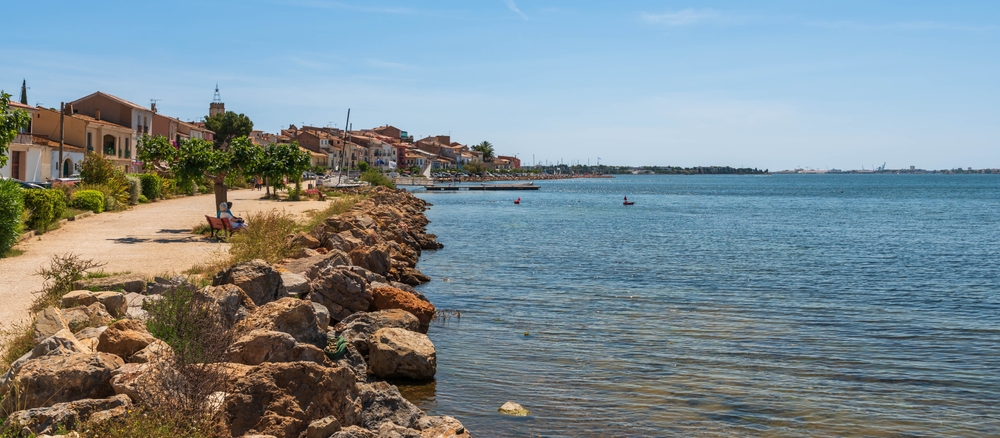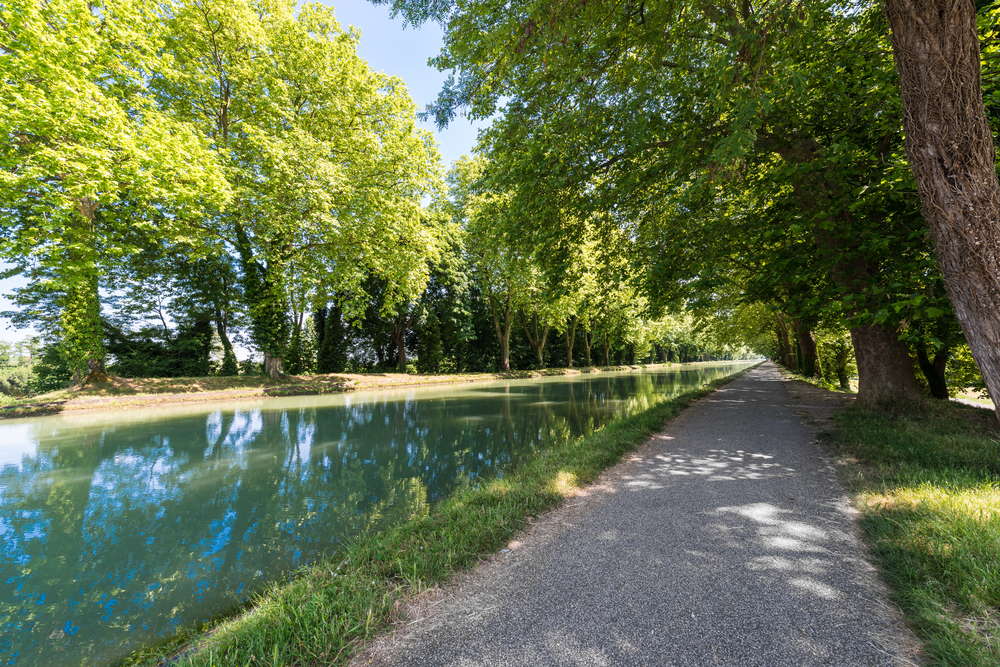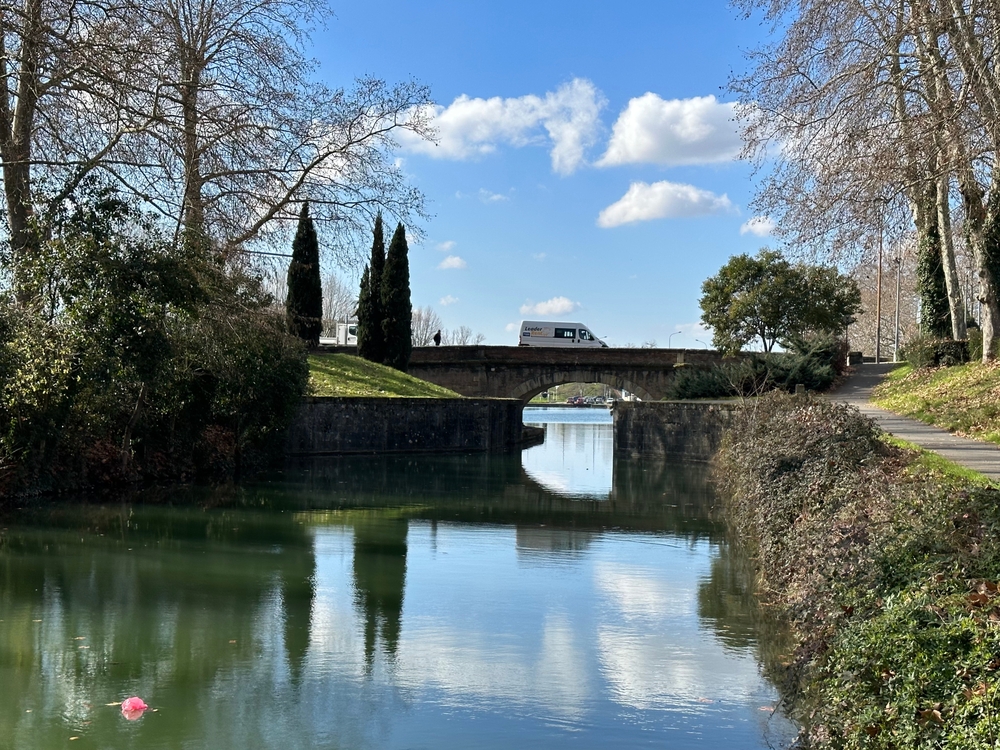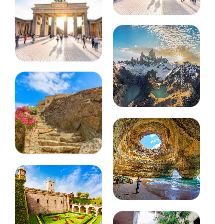The Canal du Midi by motorhome: advice, areas, itineraries

A UNESCO World Heritage Site since 1996, the Canal du Midi stretches majestically for 241 kilometres between Toulouse and the Etang de Thau. This 17th-century engineering marvel, designed by Pierre-Paul Riquet, offers an exceptional setting for a motorhome trip. With its historic locks, picturesque villages and enchanting landscapes, the Canal du Midi promises an unforgettable adventure in the heart of the Occitanie region. Discover all our tips for a successful trip along this legendary waterway.
200 audioguided tours for cities all around the world
Download1. Preparing your trip along the Canal du Midi in a motorhome

The success of your trip along the Canal du Midi in a motorhome starts with meticulous preparation. This unique journey requires planning tailored to the specific characteristics of this exceptional heritage. You’ll need to take into account the size of your vehicle, any traffic restrictions and the special features of this Occitan region.
Choosing the right period is crucial to your trip. May to October offer the best weather conditions, with a preference for spring and early autumn to avoid the summer rush. During these periods, temperatures fluctuate between 20 and 25°C, ideal for enjoying the shady banks of the canal.
As far as equipment is concerned, take along a detailed map of the Canal du Midi and download the Park4Night app, which is essential for locating authorised parking areas. Don’t forget your bikes, the perfect companions for exploring the 63 locks and surrounding villages from your parking points.
Also read the Toulouse guide:
- Canal du Midi: visits, walks and discoveries
- Activities in and around Toulouse
- Top 7 activities in Carcassonne
- Hotels Toulouse
2. Motorhome parks along the Canal du Midi

Parking is one of the major challenges when travelling along the Canal du Midi in a motorhome. Contrary to popular belief, unauthorised camping is strictly forbidden along this World Heritage waterway. Fortunately, there are a number of serviced areas along the route, offering solutions to suit all budgets.
Main service areas from Toulouse to Béziers
The Castelnaudary-Canal du Midi service area is an essential stopping-off point. This secure Camping-Car Park site offers 14 pitches with individual electric hook-ups, ideally located on the banks of the canal. Motorhome owners particularly appreciate its proximity to the Grand Bassin and its comprehensive facilities (drainage, water, electricity).
In Carcassonne, there are several options available to travellers. The municipal caravan park, close to the medieval town of Carcassonne, allows you to visit Carcassonne on foot in just a few minutes. It has 30 pitches and all the services you need for a comfortable stay.
Download the audio-guided tour to discover Carcassonne on foot and on your own
Explore the majestic medieval city and the bastide town of Saint-Louis on our audio tour of Carcassonne. This 5.7 km route takes you through 2,500 years of history, from the UNESCO heritage ramparts to the secrets of the lower town. Let our Navaway application guide you through the 27 points of interest of this exceptional city on your own.
Le Somail offers a picturesque service area right on the banks of the canal. This historic stopover village has parking for 10 to 12 motorhomes, with uninterrupted views of the barges and the historic bridge. The unique atmosphere of this 17th-century hamlet makes it an ideal place to stop.
In Béziers, the Sauclières car park stands out for its exceptional location near the famous Fonseranes locks. This area provides easy access to this engineering jewel, a veritable water staircase comprising 8 locks over 300 metres.
Complementary and alternative areas
Capestang offers a free municipal service area, ideally located for exploring this charming wine-growing village. Motorhome owners will find all the essential services and can take advantage of the proximity of the weekly market to discover local produce.
Homps is an active marina with a pay-what-you-can marina and shaded pitches. This is a strategic stop-off point for visiting the surrounding Cathar castles, while enjoying the bustle of the port.
To optimise your search, the Park4Night application is essential. It lists all the spots approved by motorhome owners, with comments and precise GPS coordinates. This active community regularly shares its discoveries along the Canal du Midi.
3. Recommended routes to discover the Canal du Midi

The Canal du Midi can be explored by motorhome along a number of different routes, depending on the length of your stay. Each route reveals different facets of this exceptional heritage, from technical innovations to wine-growing landscapes and architectural treasures.
Short itinerary: 3 days from Toulouse to Castelnaudary
This inaugural 60-kilometre route offers a first approach to the Canal du Midi by motorhome. From Toulouse, the pink city, your journey begins at Ponts-Jumeaux, the historic starting point of the canal.
Download the audio-guided tour to discover Toulouse on foot and on your own
Discover the capital of the Occitan region with our audio tour of Toulouse. This 7.9 km itinerary guides you through a 3? hour tour of the city of two hills. From the Basilique Saint-Sernin to the Capitole, via the quays of the Garonne, explore 26 places of interest with commentary from our Navaway app.
Your first stop is Villefranche-de-Lauragais, a charming 13th-century fortified town. This fortified village offers a striking contrast with the urbanism of Toulouse, and is a real introduction to the world of the canal.
The Naurouze sill is the technical highlight of this section. This watershed, located at an altitude of 190 metres, feeds the canal in both directions. Riquet’s obelisk commemorates the genius of his designer.
Castelnaudary, the capital of cassoulet, brings this first itinerary to a magnificent close. Its Grand Bassin, a veritable historic marina, is a permanent spectacle, with passing barges and lively quaysides.
Classic itinerary: 7 days from Toulouse to Béziers
This reference itinerary covers the 170 most emblematic kilometres of the Canal du Midi by motorhome. It incorporates all the previous stages, enhanced by major discoveries.
From Castelnaudary, head towards Carcassonne and discover the Fresquel locks and its canal bridge. These works of art bear witness to the technical mastery of 17th-century engineers.
Carcassonne is well worth a full day out. The medieval city, perched on its rocky outcrop, sits harmoniously alongside the canal that runs around the town. Take advantage of your parking to explore this architectural marvel on foot.
The village of Marseillette offers a peaceful stopover before reaching the remarkable structures. The Argent-Double canal bridge and the Répudre bridge, the world’s first canal bridge (1676), mark the approach to the eastern part of the canal.
Le Somail is one of our most popular stops. This unspoilt hamlet, with its winegrowers’ houses and historic inn, epitomises the Mediterranean art of living. The bookshop-gallery housed in former stables adds a unique cultural touch.
Capestang heralds the approach of the wine-growing region. This typically Languedoc village is the perfect place to discover the local appellations: Minervois, Saint-Chinian and Faugères offer tastings in an authentic setting.
The Malpas tunnel at Nissan-lez-Enserune represented a revolutionary technical challenge for its time. At 173 metres long, it crosses a limestone hill and avoids a considerable diversions.
The highlight of this route is the Fonseranes locks at Béziers. This system of 8 consecutive locks provides a 300-metre climb of 21.5 metres. The constant spectacle of boat manoeuvres fascinates young and old alike.
Complete itinerary: 10 days to Etang de Thau
If you’re feeling more adventurous, you can continue on to the Etang de Thau to experience the whole of the Canal du Midi by motorhome. This extension reveals the last secrets of Riquet’s work.
From Béziers, the Orb canal bridge offers a unique view of the Episcopal city. This 240-metre-long, 12-arch crossing is a perfect illustration of the canal’s aesthetic dimension.
The Libron structure, the only one of its kind in the world, enabled ships to cross a river at variable levels. Although it has been replaced by a new system, it bears witness to the ongoing ingenuity of its builders.
Agde, the black pearl of the Hérault, has a unique volcanic architecture. The round lock, the only one of its kind on the canal, marks the entrance to this thousand-year-old Greek city.
The pointe des Onglous in Marseillan marks the symbolic end of the canal. This tongue of land separates the canal from the Etang de Thau, the last stage before reaching the Mediterranean via Sète.
4. Traffic rules and driving tips
Driving a motorhome along the Canal du Midi obeys the classic rules of the French highway code, but there are some specific regional features that deserve attention. The departmental roads that run alongside the canal can present particular challenges for large vehicles.
The standard speed limits apply: 50 km/h in built-up areas, 80 km/h on secondary roads, and 90 km/h on expressways. Campervans weighing less than 3.5 tonnes are subject to the same speed limits as private cars. Above this weight, specific restrictions may apply.
The D613 and D6113 are the main routes between Toulouse and Carcassonne. Although these roads are passable, they sometimes pass through villages with narrow streets. Caution should be exercised, particularly at rush hour when crossing built-up areas.
The famous lines of plane trees, emblematic of the Canal du Midi landscape, line certain sections of road. These hundred-year-old trees sometimes narrow the right-of-way. Adjust your speed and keep a safe distance.
In the Aude and Hérault departments, the D610, D11 and D5 departmental roads serve the eastern part of the canal. These roads, which are generally in good condition, can experience heavy traffic during the summer months, particularly near major tourist sites.
5. Costs and budget for a trip in a motorhome
Planning the budget for your Canal du Midi motorhome holiday means there are no nasty surprises. Costs vary according to length of stay, season and level of comfort required.
Motorway tolls
The A61 motorway, which partly follows the canal, applies class 2 tariffs for motor caravans. These cost €27.10 for Toulouse-Béziers Ouest, €21.50 for Toulouse-Narbonne Sud, and €13.80 for Toulouse-Carcassonne Est. Although these prices are high, they guarantee optimum journey times.
Parking areas
Municipal car parks charge varying rates: free in Capestang, €8 to €12 a night in Castelnaudary, €15 to €20 in Carcassonne. Private sites such as Camping-Car Park offer premium services at between €12 and €18, with the option of booking in advance.
The more comfortable traditional campsites charge between €25 and €40 a night, depending on the season and facilities. They often offer swimming pools, entertainment and local shops.
Fuel and services
For a 7-day tour covering 500 kilometres, you should allow between €80 and €120 for fuel, depending on your motorhome. Draining and water supply services generally cost €3 to €5 per use at paying service areas.
Approximate overall budget for a week: €400 to €700 for a couple (excluding any motorhome hire), including parking, fuel, meals and cultural visits.
6. Activities and discoveries along the canal
The Canal du Midi by motorhome opens the door to a multitude of activities that enrich the experience beyond the simple road discovery. Each stage reveals cultural, gastronomic and natural treasures that amply justify the slow pace of the journey.
Cycling and hiking
The Canal du Midi cycle path, built on the old towpaths, runs almost the entire length of the route. This green route, shaded by two-hundred-year-old plane trees, allows you to discover locks, bridges and villages that are inaccessible to motor homes.
From your parking points, organise themed cycling loops: discover the 4 Saint-Roch locks from Castelnaudary, explore the Naurouze threshold, or visit the Fonseranes locks from the Béziers area.
The route is also dotted with footpaths. The GR®36, the route of Santiago de Compostela, crosses the canal several times, offering panoramic views of the engineering structures.
Heritage and culture
Each stopover village contains architectural treasures. The lock-keepers’ houses, built according to standard plans, bear witness to the rigorous organisation of the canal. Their passionately tended gardens create an exceptional landscape.
Museums dedicated to the canal dot the route: the Musée du Lauragais in Saint-Félix-Lauragais recounts the epic story of pastels, while the museum at Le Somail traces the history of river navigation.
The Cathar castles, accessible from your stop-off point, are a great way to extend your historical discovery. Lastours, Saissac and Cabaret offer half-day excursions from Carcassonne.
Gastronomy and vineyards
The Canal du Midi wine route reveals some prestigious appellations. Wine estates in the Minervois, Corbières and Saint-Chinian regions offer tastings and cellar tours. Many winegrowers welcome motorhomers for gourmet stops.
The local markets – Castelnaudary on Mondays, Carcassonne on Tuesdays and Saturdays, and Béziers on Fridays – offer the chance to discover local produce such as cassoulet, ewe’s milk cheese, Lauragais honey and Mediterranean specialities.
The lock restaurants, a centuries-old tradition, offer authentic cuisine in a unique setting. L’auberge du Somail, Les Bergeries de Ventenac and Le Malbec in Trèbes all perpetuate this art of canal living.
7. Seasons and weather: when to leave in a motorhome
Choosing the right period of the year is crucial to the success of your Canal du Midi motorhome trip. Each season reveals a different face of this Mediterranean region with its continental influences.
Spring: the renaissance of the canal
From April to June, the Canal du Midi is reborn after the winter. The plane trees bud, creating a canopy of soft greenery that filters the light. Temperatures of between 18 and 25°C are ideal for outdoor activities.
This period has the advantage of avoiding the summer crowds and still enjoying plenty of sunshine. The motorhome parks are less busy, making it easier to book spontaneously.
Beware, however, of the Mediterranean spring spells, which can produce intense but generally brief rainfall. Plan alternative activities and keep an eye on the weather forecasts.
Summer: entertainment at its peak
July and August transform the Canal du Midi into a major tourist artery. Temperatures can exceed 35°C, but the generous shade of the plane trees keeps the banks cool.
This is the time of year when the stopover villages come alive: night markets, festivals and harbour entertainment create a unique festive atmosphere. The other side of the coin: parking areas fill up quickly and prices reach their peak.
The regional winds – Tramontane, Autan, Marin – can blow violently and require special precautions when parking motorhomes.
Autumn: golden colours
September and October probably offer the best conditions for discovering the Canal du Midi by motorhome. Temperatures become mild again (20-28°C), while the autumn colours adorn the plane trees in spectacular golden hues.
This is the ideal season for photographers and cyclists. The crowds gradually thin out, restoring the canal’s natural serenity. The grape harvest brings the wineries to life, offering authentic experiences.
8. Recommended equipment and materials
A successful trip on the Canal du Midi in a motorhome requires equipment that is adapted to the specific characteristics of this itinerant journey. As well as the usual motorhome equipment, certain accessories are particularly useful for optimising the experience.
Navigation and documentation
Despite modern GPS systems, a detailed map of the Canal du Midi is still essential. Give preference to 1:100,000 maps, which show service areas, water points and authorised parking areas.
The Park4Night application is the reference tool for locating car parks. You can also use the CampingCar Park application to locate the network’s parking areas and the Borne Wifi application to locate Internet connections.
A guide to the locks explains how these ingenious mechanisms work. A number of specialist works detail the history and technology of each structure.
Bikes and soft mobility
Bicycles are an essential accessory for motorhomes on the Canal du Midi. They allow you to explore the banks that are inaccessible to vehicles and to tour from the parking areas.
Make sure you have a bike rack to fit your motorhome and check the compulsory signs. Electric bikes make it easier to travel on hilly routes, particularly through the Lauragais region.
A bike repair kit, pump and secure lock complete the essential cycling equipment.
Comfort and leisure
Tables and folding chairs are available to make the most of the shady pitches along the canal. An awning or tarpaulin provides shade from the scorching Mediterranean sun.
Binoculars and cameras immortalise the wildlife and landscapes. The canal is home to herons, kingfishers and moorhens, all of which put on a beautiful natural show.
A first-aid kit suitable for outdoor activities and mosquito repellent are useful, especially near water.
9. Safety and regulations
If you’re travelling safely along the Canal du Midi in your motorhome, you’ll need to observe a number of rules specific to this protected heritage environment. Preservation issues impose particular constraints on visitors.
Unauthorised parking is strictly prohibited along riverbanks and in sensitive natural areas. Fines can be as high as €1,500 and the vehicle may be impounded. Use only authorised parking areas.
Campfires are prohibited at all times of the year due to the risk of fire. Barbecues are only permitted in equipped areas and in dedicated pitches. Please follow these instructions to the letter, especially during the summer months.
Cycling on the riverbanks is subject to rules of courtesy: priority for pedestrians, moderate speed near locks, compulsory stop when passing boats. The towpaths can be slippery after rain.
Swimming is strictly forbidden in the canal for obvious safety reasons. The steep banks and river traffic present real dangers. Instead, use the nearby lakes and rivers.
In an emergency, dial 15 (SAMU), 17 (Police/Gendarmerie) or 18 (Fire brigade). The European number 112 also works. Memorise these numbers and keep your phone charged.
10. Alternatives and extensions to the trip
The Canal du Midi in a motorhome can be extended in a number of ways to make your stay even more interesting. The rich heritage of the Occitanie region offers natural extensions to the discovery of the canal.
The Canal de la Robine, from Narbonne to Port-la-Nouvelle, is a natural extension to the Mediterranean. This less-frequented section reveals the landscapes of the Narbonnaise and its wild lakes.
The Cathar castles dotted around the region are well worth a diversion from your main stops. Quéribus, Peyrepertuse and Aguilar offer exceptional views over the vineyards and the Corbières.
The Montagne Noire, the source of the canal’s water supply, offers tours of Riquet’s hydraulic works. The dams at Saint-Ferréol and La Galaube reveal the technical prowess of the 17th century.
When it comes to gastronomy, the wine route can be extended to prestigious appellations: Pic Saint-Loup, Terrasses du Larzac and Languedoc-Roussillon all offer exceptional terroirs accessible by motorhome.
The Haut-Languedoc and Narbonnaise en Méditerranée regional nature parks offer complementary nature trails. They combine built heritage with environmental discovery.
In conclusion, the Canal du Midi by motorhome offers much more than a simple trip: it’s a total immersion in the Mediterranean art of living, with its thousand-year-old heritage and the innovations of the Grand Siècle. This unique adventure, accessible to all motorhomers who care about this jewel of humanity, will leave you with unforgettable memories. Whether you choose to explore the canal for a few days or follow it all the way to the Grande Bleue, every kilometre reveals new treasures. Let yourself be carried away by the slow pace of this exceptional waterway and discover why the Canal du Midi remains one of the most beautiful motorhome destinations in France. For an even richer discovery, don’t hesitate to complete your journey with a guided tour of Toulouse or Carcassonne, thanks to the Navaway tours, which will reveal all the secrets of these exceptional cities.
Frequently asked questions
Is it free to park along the Canal du Midi?
Free parking is available at certain municipal areas such as Capestang, but it is strictly forbidden to park freely along the banks. Unauthorised camping is punishable by fines of up to €1,500, as the Canal du Midi is a UNESCO-listed site. To respect this exceptional heritage, it’s best to use equipped areas, whether free or paying.
When is the best time to visit the Canal du Midi by motorhome?
Spring (May-June) and autumn (September-October) offer the best conditions: pleasant temperatures between 20-25°C, fewer tourists and more affordable parking rates. Summer remains magnificent despite the heat and bustle, while autumn offers spectacular colours with its golden plane trees.
How much does a week in a motorhome on the Canal du Midi cost?
Expect to pay between €400 and €700 for a week as a couple (not including motorhome hire): €80-120 for fuel, €10-15 per night at a service area on average, €27 for the Toulouse-Béziers toll if you take the motorway, plus meals and visits. Free municipal service areas can significantly reduce the budget.
Do I need to book the motorhome parks in advance?
In high season (July-August), booking is strongly recommended, especially for the most popular areas such as Carcassonne and Béziers-Fonseranes. The Camping-Car Park network allows you to book online. Out of season, spontaneous arrivals are generally possible, but check via the Park4Night application.
Is the Canal du Midi accessible to large motorhomes?
The main roads (D613, D6113) are suitable for all sizes of vehicle, but some of the villages they pass through have narrow passages. The main service areas accept motorhomes up to 12 metres long. Avoid small departmental roads with vehicles over 7 metres long, and check local restrictions.
Can you sail on the Canal du Midi with your own boat?
Yes, the Canal du Midi is open to private navigation subject to certain conditions: a navigation licence, compliance with gauges (30m x 5.05m maximum), and payment of navigation fees. Boats over 15 hp require a river licence. Many bases also offer hire of houseboats without a licence.
200 audioguided tours for cities all around the world
Download
